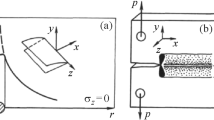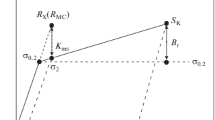Abstract
Advanced high-strength materials including metallic glasses (MGs) and nanocrystalline (NC) metals have attracted great attentions due to their promising mechanical properties. However, since they usually exhibit relatively brittle fracture behavior, a proper failure criterion is urgently required for the safety design of structural components and devices using these high-strength materials. It has been found that the conventional failure criteria may not soundly explain the fracture behaviors of MGs, while the ellipse criterion shows promising universality for well describing the fracture behaviors of several kinds of high-strength materials under various loading conditions. In this study, the principal stress form of the ellipse criterion was derived for the first time, and the two-dimensional failure surfaces according to this criterion were plotted and compared with the other predictions, as well as the experimental and simulation results of MGs and NC metals. The results confirm the applicability of the ellipse criterion for predicting the failure of high-strength materials, and may also improve the understanding of strength and fracture of various materials.










Similar content being viewed by others
References
Ashby MF, Greer AL (2006) Metallic glasses as structural materials. Scr Mater 54:321–326
Bruck HA, Christman T, Rosakis AJ, Johnson WL (1994) Quasi-static constitutive behavior of Zr41.25Ti13.75Ni10Cu12.5Be22.5 bulk amorphous alloys. Scr Metall Mater 30:429–434
Chen Y, Jiang MQ, Wei YJ, Dai LH (2011) Failure criterion for metallic glasses. Philos Mag 91:4536–4554
Chen C, Gao M, Wang C, Wang WH, Wang TC (2016) Fracture behaviors under pure shear loading in bulk metallic glasses. Sci Rep 6:39522
Cheng S, Spencer JA, Milligan WW (2003) Strength and tension/compression asymmetry in nanostructured and ultrafine-grain metals. Acta Mater 51:4505–4518
Dong FY, Zhang P, Pang JC, Ren YB, Yang K, Zhang ZF (2015) Strength, damage and fracture behaviors of high-nitrogen austenitic stainless steel processed by high-pressure torsion. Scr Mater 96:5–8
Dongare AM, Rajendran AM, LaMattina B, Zikry MA, Brenner DW (2010) Tension–compression asymmetry in nanocrystalline Cu: high strain rate vs. quasi-static deformation. Comput Mater Sci 49:260–265
Donovan PE (1989) A yield criterion for \(\text{ Pd }_{40}\text{ Ni }_{40}\text{ P }_{20}\) metallic glass. Acta Metall 37:445–456
Greer AL, Cheng YQ, Ma E (2013) Shear bands in metallic glasses. Mater Sci Eng R 74:71–132
Han B, Mohamed F, Lavernia E (2003a) Mechanical properties of iron processed by severe plastic deformation. Metall Mater Trans A 34:71–83
Han B, Mohamed F, Lee Z, Nutt S, Lavernia E (2003b) Mechanical properties of an ultrafine-grained Al-7.5 Pct Mg alloy. Metall Mater Trans A 34:603–613
Hosford WF (2005) Mechanical behavior of materials. Cambridge University Press, Cambridge
Jiang MQ, Ling Z, Meng JX, Dai LH (2008) Energy dissipation in fracture of bulk metallic glasses via inherent competition between local softening and quasi-cleavage. Philos Mag 88:407–426
Kruzic JJ (2016) Bulk metallic glasses as structural materials: a review. Adv Eng Mater 18:1308–1331
Lee ML, Li Y, Schuh CA (2004) Effect of a controlled volume fraction of dendritic phases on tensile and compressive ductility in La-based metallic glass matrix composites. Acta Mater 52:4121–4131
Lei X, Wei Y, Wei B, Wang W-H (2015) Spiral fracture in metallic glasses and its correlation with failure criterion. Acta Mater 99:206–212
Lewandowski JJ, Lowhaphandu P (2002) Effects of hydrostatic pressure on the flow and fracture of a bulk amorphous metal. Philos Mag A 82:3427
Liu C, Huang Y, Stout MG (1997) On the asymmetric yield surface of plastically orthotropic materials: a phenomenological study. Acta Mater 45:2397–2406
Liu ZQ, Qu RT, Zhang ZF (2015) Elasticity dominates strength and failure in metallic glasses. J Appl Phys 117:014901
Lund AC, Schuh CA (2003) Yield surface of a simulated metallic glass. Acta Mater 51:5399–5411
Lund AC, Schuh CA (2005) Strength asymmetry in nanocrystalline metals under multiaxial loading. Acta Mater 53:3193–3205
Luo H, Shaw L, Zhang LC, Miracle D (2005) On tension/compression asymmetry of an extruded nanocrystalline Al–Fe–Cr–Ti alloy. Mater Sci Eng A 409:249–256
Meyers MA, Chawla KK (1999) Mechanical behavior of materials. Prentice Hall, New Jersey
Paul B (1968) Macroscopic criteria for plastic flow and brittle fracture. In: Liebowitz H (ed) Fracture, an advanced treatise. Academic Press, New York, pp 313–496
Narasimhan R, Tandaiya P, Singh I, Narayan RL, Ramamurty U (2015) Fracture in metallic glasses: mechanics and mechanisms. Int J Fract 191:53–75
Qiao J, Jia H, Liaw PK (2016) Metallic glass matrix composites. Mater Sci Eng R 100:1–69
Qu RT, Eckert J, Zhang ZF (2011) Tensile fracture criterion of metallic glass. J Appl Phys 109:083544
Qu RT, Stoica M, Eckert J, Zhang ZF (2010) Tensile fracture morphologies of bulk metallic glass. J Appl Phys 108:063509
Qu RT, Zhang ZF (2013a) Compressive fracture morphology and mechanism of metallic glass. J Appl Phys 114:193504
Qu RT, Zhang ZF (2013b) A universal fracture criterion for high-strength materials. Sci Rep 3:1117
Qu RT, Zhang ZJ, Zhang P, Liu ZQ, Zhang ZF (2016) Generalized energy failure criterion. Sci Rep 6:23359
Ritchie RO (2011) The conflicts between strength and toughness. Nat Mater 10:817–822
Schuh CA, Hufnagel TC, Ramamurty U (2007) Mechanical behavior of amorphous alloys. Acta Mater 55:4067–4109
Schuh CA, Lund AC (2003) Atomistic basis for the plastic yield criterion of metallic glass. Nat Mater 2:449
Silva VD (2006) Mechanics and strength of materials. Springer, Berlin
Song Z-Q, Ma E, Xu J (2017) Failure of Zr61Ti2Cu25Al12 bulk metallic glass under torsional loading. Intermetallics 86:25–32
Sun BA, Wang WH (2015) The fracture of bulk metallic glasses. Prog Mater Sci 74:211–307
Tomar V, Zhou M (2006) Tension–compression strength asymmetry of nanocrystalline alpha–Fe\(_2\)O\(_3\)+fcc–Al ceramic-metal composites. Appl Phys Lett 88:233107
Wang Z, Qu RT, Scudino S, Sun BA, Prashanth KG, Louzguine-Luzgin DV, Chen MW, Zhang ZF, Eckert J (2015) Hybrid nanostructured aluminum alloy with super-high strength. NPG Asia Mater 7:e229
Wu FF, Zhang ZF, Mao SX, Peker A, Eckert J (2007) Effect of annealing on the mechanical properties and fracture mechanisms of a Zr56.2Ti13.8Nb5.0Cu6.9Ni5.6Be12.5 bulk-metallic-glass composite. Phys Rev B 75:134201
Wu FF, Zhang ZF, Peker A, Mao SX, Das J, Eckert J (2006) Strength asymmetry of ductile dendrites reinforced Zr- and Ti-based composites. J Mater Res 21:2331–2336
Yapici GG, Beyerlein IJ, Karaman I, Tom CN (2007) Tension–compression asymmetry in severely deformed pure copper. Acta Mater 55:4603–4613
Yu CY, Sun PL, Kao PW, Chang CP (2005) Mechanical properties of submicron-grained aluminum. Scr Mater 52:359–363
Zhang P, Qu S, Yang MX, Yang G, Wu SD, Li SX, Zhang ZF (2014) Varying tensile fracture mechanisms of Cu and Cu–Zn alloys with reduced grain size: from necking to shearing instability. Mater Sci Eng A 594:309–320
Zhang ZF, Eckert J (2005) Unified tensile fracture criterion. Phys Rev Lett 94:094301
Zhang ZF, Eckert J (2007) The physical nature of materials strengths. Adv Eng Mater 9:143–146
Zhang ZF, Eckert J, Schultz L (2003a) Difference in compressive and tensile fracture mechanisms of \(\text{ Zr }_{59}\text{ Cu }_{20}\text{ Al }_{10}\text{ Ni }_{8}\text{ Ti }_{3}\) bulk metallic glass. Acta Mater 51:1167–1179
Zhang ZF, He G, Eckert J, Schultz L (2003b) Fracture mechanisms in bulk metallic glassy materials. Phys Rev Lett 91:045505
Zhang ZF, Qu RT, Liu ZQ (2016) Advances in fracture behavior and strength theory of metallic glasses. Acta Metall Sin 52:1171–1182
Zhao Y, Topping T, Bingert JF, Thornton JJ, Dangelewicz AM, Li Y, Liu W, Zhu Y, Zhou Y, Lavernia EJ (2008) High tensile ductility and strength in bulk nanostructured nickel. Adv Mater 20:3028–3033
Zhu T, Li J (2010) Ultra-strength materials. Prog Mater Sci 55:710–757
Acknowledgements
This work was financially supported by the National Natural Science Foundation of China (NSFC) under Grant Nos. 51771205 and 51331007, as well as the SYNL Project for Young Talents.
Author information
Authors and Affiliations
Corresponding authors
Additional information
Publisher's Note
Springer Nature remains neutral with regard to jurisdictional claims in published maps and institutional affiliations.
Rights and permissions
About this article
Cite this article
Qu, R.T., Zhang, Z.F. Failure surfaces of high-strength materials predicted by a universal failure criterion. Int J Fract 211, 237–252 (2018). https://doi.org/10.1007/s10704-018-0286-7
Received:
Accepted:
Published:
Issue Date:
DOI: https://doi.org/10.1007/s10704-018-0286-7




